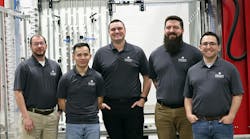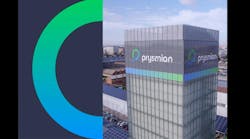Maybe it was the college summers I spent sweeping sawdust, making coffee runs and working as a “gofer” on construction jobs that first gave me an eye for unusual construction jobs. While working for a test boring and drilling company that gathered core samples of rock, I spent a summer working on an offshore drilling platform two miles off the coast of New Hampshire, and another summer living in a cabin on the Allagash River in northern Maine on the Canadian border while drilling for potential sources of aggregate for a dam that was never built. I even spent several weeks underground, inside a dam in upstate New York, cleaning out vent holes drilled into a shelf of shale on which the dam was built, to release the methane gas percolating through the rock.
It could have been the many dinner table conversations my family had about New York metropolitan-area construction projects because of my father's career in the surety bonding business. Or perhaps it was the cold winter day my dad took me and my two brothers to the World Trade Center construction site to get a first glimpse of what would be a mammoth building when it was first growing out of Manhattan's bedrock.
Some way, somehow, I became really interested in construction projects. It was only natural when I came to Electrical Wholesaling in 1982 that I particularly enjoyed article assignments that offered opportunities to visit construction sites with electrical distributors to see how they handled the delivery and logistics for construction jobs.
It wasn't only the big jobs that were of interest. In fact, in some ways, the smaller jobs were just as much fun to cover.
Kennedy Electrical Supply's Jerry Eichwald once took me to the sub-basement of the Gimbels department store on Manhattan's Herald Square to meet the electrician who got the store back on line during a power outage a day before Macy's across the street. Kennedy had supplied the generators.
Years later, Eichwald took me to the site of an office being built for a zillionaire commodities trader who bought and sold coffee futures. The trader insisted on having his own espresso machine so he could sample the coffee he was buying and selling. Workers were putting in the plumbing lines for the machine the day of my visit.
While visiting a Wall Street bank vault to see the installation of under-carpet wiring, I was thrown off the job site by a union electrical contractor who didn't want me taking photographs inside the vault.
One of the reasons I find construction jobs — big and small — so interesting is because they put electrical distributors to the test, and give them ample opportunity to walk all the talk about the importance of having the right inventory when and where the customer needs it.
John Moore, who was president of Moore Electric Supply, Charlotte, N.C., (now part of Hughes Supply) once told me that one of the biggest challenges for an electrical distributor on a big construction job is keeping the service level high throughout a project that can span a year or more. Moore said the customer will easily forget your impeccable sourcing and delivery throughout the life of a construction job if your truck shows up on the job site the day before the inspector's final walk-through of the job loaded with the wrong receptacle plates or cracked lenses for the light fixtures.
Despite a still-sluggish construction climate gripping many metropolitan areas, plenty of interesting construction jobs have recently been completed. This article showcases several of these jobs. They aren't always the biggest job in the world, but they all have unique features that make them in some way notable or perhaps a bit unusual.
If you supplied or are currently supplying an interesting construction project and would like Electrical Wholesaling to feature it, please call me at (913) 967-1743 or e-mail me at [email protected].
— Jim Lucy
THE BIGGEST TROPHY JOB OF THEM ALL
World Trade Center, New York
One of the highest profile trophy jobs ever built in the United States will be the 1,776-foot Freedom Tower, expected to break ground later this year at the World Trade Center site. The building is expected to have 2.6 million square feet of commercial space and be completed in 2008. Wind turbines will generate 20 percent of the building's electrical power needs.
Another project is well underway at the WTC site — 7 World Trade Center, a 1.7-million-square-foot office building.
Leonard Impastato, a 40-year electrical industry veteran employed by Five Star Electric, works with John McManus, the general foreman, to supervise a team of 45 electricians on the landmark $700 million initial rebuild of the World Trade Center.
“There's a real spirit of cooperation that you normally wouldn't see on a construction project,” Impastato says. “You can almost feel it when you walk through the area. It's heartening to see the area coming back and becoming more and more vibrant. Every week I go down there I see an increased level of activity.”
Five Star, E-J Electric Installation Co., and Zwicker Electric are providing electrical, lighting and control services for the construction of 7 World Trade (7 WTC).
The destruction of the Twin Towers structurally weakened 7 WTC, which was built on top of a substation building that supplied electricity to downtown Manhattan. The construction crew leveled the existing building and cleared the land for the new 7 WTC.
Five Star and E-J Electric are preparing the space for the Con Ed utility substation, which will include five 138kV transformers. Once that phase is complete, Zwicker will provide electrical services for the core of the 50-story, parallelogram-shaped high-rise, which will be built on the footprint of the former 7 WTC and the surrounding area.
Dwight Millman, a project manager for E-J Electric, says his team faced many challenges in the initial phases of the project. Because the team was working on the site of the wreckage of an existing building, it was difficult to safely access the job site. The construction workers also encountered underground obstructions, remnants of the former building, and massive amounts of groundwater. To make the building structurally sound and protect it against future possible attacks, the engineers specified that many of the walls be 2 feet thick in the lower levels of the building. The first five floors were constructed of poured concrete, and a steel-based structure will be built on top of this foundation to form the shell of the building.
“There are massive amounts of concrete from the cellar to floor,” Impastato says. “It looks like a fortress.”
On a traditional high-rise construction project, a team builds one floor at a time, but on the 7 WTC project, the electricians are working on four or five different floors simultaneously. Five Star is installing thousands of feet of cable tray, conduit, and power and control cable, putting in lighting fixtures, and placing conduit into the poured concrete.
E-J Electric, the Long Island City, N.Y.-based firm that installed the security system for the original WTC, is providing a temporary service of 4,000A for the initial and future phases of construction, installing nine miles of conduit for medium-voltage and high-voltage distribution duct banks and putting in 8-foot by 8-foot horizontal ground plates and ground rods for lightning protection.
Last December, New York's governor and mayor led a “topping off” ceremony to celebrate the end of the first phase of the project — the completion of the five-story concrete base of the building.
New York Governor George Pataki said the Consolidated Edison power substation located in 7 World Trade Center is expected to begin service by the end of May, replacing equipment destroyed in the attack.
— Amy Florence Fischbach
AWARD-WINNING LIGHTING
St. John the Baptist Catholic
Church at Skaggs Catholic Center, Draper, Utah
Although Consolidated Electrical Distributors' Monte Robertson, outside salesperson, didn't really consider St. John the Baptist Catholic Church a high-profile job for CED, this contemporary Catholic church certainly qualifies as a trophy job for the lighting designer on the project.
Joseph M. “Jody” Good, of Spectrum Engineers, Salt Lake City, won the prestigious 2003 GE Edison Award from GE Lighting for his work on the church.
The lighting for this new 32,000-square-foot contemporary worship space was designed to complement the extensive natural daylighting. The lighting maintains the open feel of the architecture, brings intimacy to the space as required and has enough flexibility to accommodate a range of activities — from education to worship.
“We had to capitalize on daylighting while minimizing the differences that worshipers perceived between day and night services — a real challenge for this daylighted facility,” said Good.
“It was all done up really nice,” said Matt Barlow, co-owner of Salt Lake City's Network Electric, the electrical contractor on the project. “They spared no expense on the light fixtures.”
Indirect lighting, provided by GE T5/HO Starcoat SPX35 lamps, creates a glow to the church at night. In areas with lower ceilings, downlights with energy-efficient GE 100W Halogen-IR PAR38 or 32W Triple Biax compact fluorescent lamps provide task and circulation lighting. At higher ceiling planes, downlights with Quartzline halogen 500W frosted T4 or PAR56 medium flood lamps provide additional lighting layers.
The lighting control system includes special lighting for artwork, gathering areas, worship activities and special events. Presets effectively integrate electric lighting and daylighting throughout the space. The total connected load of 2.11W per square foot falls below the allowed 2.2W per square foot. The lighting power density is about 0.2W per square foot during the day because of the extensive use of daylighting.
“Even during evening hours, the lighting consumes well below 2.11W per square foot, because the dimming system limits the halogen sources to 80 percent of full power,” Good said.
“Seeing it finished was pretty interesting,” said CED's Robertson. “At first, I was a little bit skeptical because there's no carpeting on the floor; it's cement with a finish. I kept thinking, ‘This sounds more like a warehouse.’
“It was nice to see it finished. It really did turn out very nicely.”
— Sarah Tobaben Dolash
ALL THE COMFORTS OF HOME
The University of Oregon football team's weight room and locker room, Eugene, Ore.
Think back to locker rooms and weight rooms of your high school or college years. The unmistakable odors of a mildewed two-week-old bath towel and Ben Gay lineament assault you as soon as you push open the door. Dingy lighting reveals dented gray lockers crammed together in narrow aisles.
Now let's step into the University of Oregon's $3 million weight room and locker room for the Oregon Ducks football team. It reportedly outshines NFL locker rooms and the classiest health clubs in the land. According to a report in The Seattle Times, the two-story locker room has three $15,000 60-inch plasma TVs — two of which are rigged for Xbox games. The newspaper says each of the 120 lockers is individually ventilated, contains outlets for video games and the Web, and has a security system activated by a code that includes a player's uniform number and a scan of his thumbprint. One locker is reserved for Ducks fan and Nike chairman Phil Knight (under the heading “No. 1, Knight, Hillsboro, Ore.”).
Award-winning lighting design and technology help create the ambience. Pacific Lightworks, Portland, Ore., won a 2004 GE Edison Award of Merit and Award for Sustainable Design from GE Lighting, Nela Park, Ohio.
Crescent Electric Supply, Portland, Ore., supplied GE Lighting products for the weight room.
According to information on the Pacific Lightworks Web site, “The locker room surrounds a central meeting point where a preset control system provides several lighting scenes with 100W HIR PAR38 lamps and 3,500K fluorescent T8 and T5/HO lamps. Wallwashers with T5/HO illuminate locker blocks, define spokes to inner zones, highlight graphics and provide lighting for stairs.
“This lighting design achieved 0.77W per square foot, which is 54 percent below the maximum allowance of 1.4W per square foot. A preset control system provides several lighting scenes featuring 100W halogen HIR PAR38 and 3,500K T8 and T5/HO fluorescent lamps.”
In the weight room, the “O” shown in the photograph is backlit in yellow, the school color, using low-energy, long-life LEDs to create a sense of arrival. “Cribbing is anchored to the floor with concealed, fluorescent horizon lights with T5 lamps,” says the Pacific LightWorks. “In the weight room, T8 3,500K lamps create floating planes, while halogen PAR lamps highlight weight equipment platforms and lifters for video recording and theatrical presentations. Fixtures with T5/HO fluorescent lamps highlight exercise stretch bars and define and expand the mezzanine. T5, T5/HO and T8 fluorescent lamps and halogen accent sources are managed within a dimming/switching/shade control system.
“Lighting power density is 0.84W per square foot during normal occupancy, excluding daylighting opportunities, and 0.10W per square foot after hours. Photocell and A/V controlled shades optimize energy savings and comfort and create a theatrical environment for presentations.”
ALL ABOARD!
Lighting Horseshoe Curve, Altoona, Pa.
For The Hite Co. and Osram Sylvania, lighting Horseshoe Curve at this year's Fourth of July festivities in Altoona, Pa., is less a trophy job and more an “exposure” opportunity. The event will be reminiscent of the famous 1954 “Sylvania Big Shot,” which celebrated the curve's 150th anniversary and featured the simultaneous deployment of more than 6,500 Sylvania Blue Dot flashbulbs to light Horseshoe Curve.
“It was a pretty notable event at that time. The photograph appeared in Life magazine,” said Jack Hatch, who retired from The Hite Co. as vice president last year but continues to work for the company part time on special projects.
Although the 1954 event promoted camera flashbulbs, this year's event will feature some of today's most technologically innovative lighting products, including incandescent tungsten and LED lighting.
The Hite Co., Altoona, Pa., and Osram Sylvania, Danvers, Mass., are teaming up with Norfolk Southern Railroad and a number of local Altoona sponsors to create an evening spectacular in celebration of the 150th anniversary of Horseshoe Curve.
Pennsylvanians know all about Horseshoe Curve. In 1854, an enterprising young civil engineer named J. Edgar Thomson opened the first railway to scale the mighty Allegheny Mountains in Central Pennsylvania. To avoid a sharp incline, which would be impossible for heavy steam trains to manage, Thomson routed the right-of-way in a horseshoe shape so the rise would be gradual. The feat was considered a major engineering masterpiece at the time and was pivotal to opening commerce across the continental United States.
According to Hatch, the 1954 Big Shot lighting event centered around 6,500 flashbulbs mounted to aluminum pies pans. The flashbulb pie pans were in turn mounted to wooden stakes and wired so that they all went off at once.
For this year's event, Southern Norfolk will cease normal train traffic, and a 2,500 foot Sylvania-lighted train with take the track for the evening's event.
“This is going to be a moving event,” said Hatch. “These lights are going to be on this train. Norfolk Southern is making the train available about five days ahead of time, and Sylvania has electrical crews coming in.” The Hite Co. has arranged for the generators that will fuel the lighting show.
For The Hite Co., sponsoring the event makes perfect sense. Founded in 1948, The Hite Co. has been a Sylvania distributor for more than 50 years. With 12 Pennsylvania branch locations and one location in New York, about 25 percent of its business is in lighting sales.
“When anybody thinks of The Hite Co., they think of us as lights,” said Hatch. “We've had 20 percent increases in lamp sales in the last two or three years because we have some people who specialize in retrofit,” he added.
“Horseshoe Curve is going to look like a diamond necklace from the sky. The Hite name will be connected with it.”
— Sarah Tobaben Dolash
LEDs WOW LAS VEGAS AT HARD ROCK
Hard Rock Hotel & Casino, Las Vegas
It's going to be several years before your average electrical distributor stocks light-emitting diodes (LEDs) for large-scale lighting projects, but those days are coming. LEDs are just too darn much fun — and amazingly energy-efficient.
To see LEDs at work and play, if you are visiting Las Vegas anytime soon, check out the lighting show they put on every night on the façade of the Hard Rock Hotel and Casino. Color Kinetics, Boston, one of the early pioneers in LED technology, teamed up with Hard Rock lighting designer Warwick Stone and 4Wall Entertainment, a full-service entertainment lighting company to create an eye-popping exterior that's lit with the latest in cutting-edge LED technology. Along with the light show, the new LED system saves the facility approximately $41,000 per year in operational savings.
According to Color Kinetics, the project team was tasked with generating grand-scale, color-changing effects to wash the 120-foot façade with high output and color saturation. Custom fixtures were assembled by 4Wall Entertainment using five ColorBlast 12 units each; the bottom units with frosted lenses to cast a wide beam angle, and the top units with clear lenses to maximize upward throw of the light 10 stories up. A total of 300 ColorBlast 12 units were installed in this fashion to wash the façade with vibrant, dynamic color. The LED-based system can be programmed to run customized light shows according to special events, attractions and holidays using the resort's existing DMX control system.
Color Kinetics also proudly promotes the fact that the LEDs draw only $1,900 in electricity within one year. The previous metal halide-based fixtures drew approximately $18,000 annually. The estimated maintenance expense for the LED-based units is $600, while the maintenance expense for the previous fixtures was roughly $25,000 — not including the additional costs of replacing the dichroic filters and ballasts on a periodic basis.








